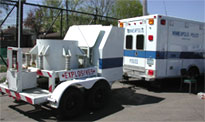| OFFICER RICHARD P. MILLER, SR. |
| Appointed April 1,1963 |
| Died August 25, 1981 |
 Minneapolis Police Patrolman Richard P. Miller was riding alone in his squad car shortly after 5 p.m. on a rainy August 25, 1981 when he responded to a report of a stolen vehicle at 16th and Girard Avenues North. Minneapolis Police Patrolman Richard P. Miller was riding alone in his squad car shortly after 5 p.m. on a rainy August 25, 1981 when he responded to a report of a stolen vehicle at 16th and Girard Avenues North.He drove to 16th and Girard and found a red pickup truck parked at the southeast corner of the intersection. It was occupied by 22-year old Isaac Brown, and his 17-year old girlfriend. Miller apparently realized Brown had a shotgun and quickly called for back-up, got out of his squad and approached the front of the truck. He had his hand on his holstered service revolver as Brown got out of his truck. Miller questioned him as to who owned the vehicle. Brown already had his hand placed in a small shaving-type bag that contained a .357 magnum revolver. He pulled out the gun and shot Miller twice in the chest at close range. Miller dropped to his knees, yet drew his revolver and fired several shots that missed before he fell to the street. Brown fired three more shots at Miller and then fled with his girlfriend. He fired again from farther away. In the end, Miller was The shooting set off a wide spread manhunt by dozens of law enforcement agencies. Brown was identified as the suspect almost immediately after the shooting. Miller was rushed to Hennepin County Medical Center where he died of his wounds an hour later. After fleeing the scene, Brown and his girlfriend got a ride to a friend’s apartment in South Minneapolis. They stayed there for nearly three days before a minister helped convince them to surrender at police headquarters in City Hall. Within minutes of his arrest, Brown confessed to shooting Miller. The murder weapon Brown used was recovered from the same apartment in which he had been hiding. Ironically, it had been stolen from another police officer’s van broken into three months earlier. Isaac Brown was indicted by a Hennepin County grand jury on September 8, 1981 on a first-degree murder charge. He pled not guilty and claimed to be under the influence of marijuana and alcohol at the time of the killing. However, in January of 1982, following a five day trial, he was the first person convicted under a change in Minnesota’s first-degree murder statute During the trial, several St. Paul police officers testified about their previous contacts with Brown, who was a resident of their city. Brown had a lengthy arrest record, including burglary, auto theft and drug trafficking. One officer reported that four months before Miller’s death, Brown told him that “the next time he’s arrested, he’s going to make sure that he has a pistol with him and that he would never be taken alive again. He would take a few cops with him, too.” Brown’s girlfriend was given immunity in return for her testifying against him. Prosecuting attorney, John Brink, recommended that Brown never be paroled because of what he called “Brown’s callous disregard for human life.” Miller’s death raised questions about whether the one-person patrol policy, adopted by Chief of Police Tony Bouza in 1980, subjected officers to unnecessary danger. The Police Officers Federation of Minneapolis immediately entered a strong protest against the one-person squad car patrolling. Four hours after the shooting, the Federation was picketing City Hall to protest the year-old policy and was especially vehement in objecting to the use of lone officers in high-crime areas. Miller was 59 years old and a police veteran of over 18 years. He was planning to retire in 18 months to his lake cabin up north when he was slain. He was survived by his wife, Lea, a daughter and a son. He was a World War II Navy veteran and resided in North Minneapolis his entire life. Funeral services were held on August 28 at Christ English Lutheran Church. He was buried at Crystal Lake Cemetery in North Minneapolis. |
Police Officers Federation of Minneapolis
P.O. Box 18187
Minneapolis, MN
55418
P.O. Box 18187
Minneapolis, MN
55418

